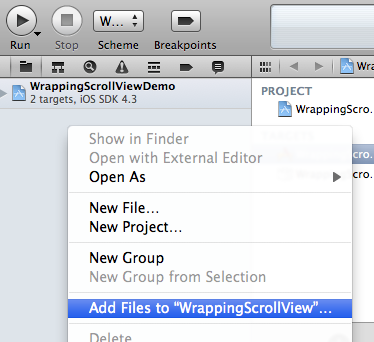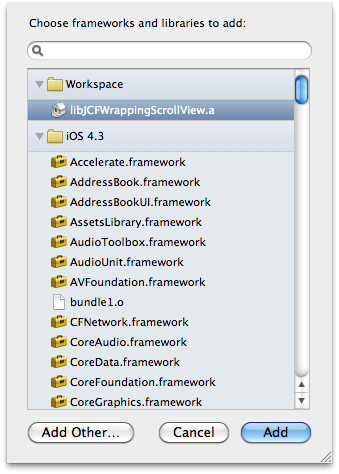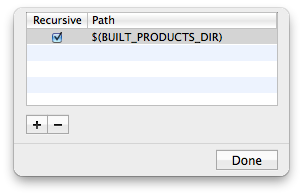|
|
||
|---|---|---|
| SDWebImage.xcodeproj | ||
| .gitignore | ||
| LICENSE | ||
| MKAnnotationView+WebCache.h | ||
| MKAnnotationView+WebCache.m | ||
| README.md | ||
| SDImageCache.h | ||
| SDImageCache.m | ||
| SDImageCacheDelegate.h | ||
| SDWebImageCompat.h | ||
| SDWebImageDecoder.h | ||
| SDWebImageDecoder.m | ||
| SDWebImageDownloader.h | ||
| SDWebImageDownloader.m | ||
| SDWebImageDownloaderDelegate.h | ||
| SDWebImageManager.h | ||
| SDWebImageManager.m | ||
| SDWebImageManagerDelegate.h | ||
| SDWebImagePrefetcher.h | ||
| SDWebImagePrefetcher.m | ||
| UIButton+WebCache.h | ||
| UIButton+WebCache.m | ||
| UIImageView+WebCache.h | ||
| UIImageView+WebCache.m | ||
README.md
Web Image
This library provides a category for UIImageVIew with support for remote images coming from the web.
It provides:
- An UIImageView category adding web image and cache management to the Cocoa Touch framework
- An asynchronous image downloader
- An asynchronous memory + disk image caching with automatic cache expiration handling
- A guarantee that the same URL won't be downloaded several times
- A guarantee that bogus URLs won't be retried again and again
- Performances!
Motivation
As a dummy Objective-C developer working on my first iPhone application for my company (Dailymotion), I've been very frustrated by the lack of support in the Cocoa Touch framework for UITableView with remote images. After some Googling, I found lot of forums and blogs coming up with their solution, most of the time based on asynchronous usage with NSURLConnection, but none provided a simple library doing the work of async image grabbing + caching for you.
Actually there is one in the famous Three20 framework by Joe Hewitt, but it's a massive and undocumented piece of code. You can't import just the the libraries you want without taking the whole framework (damn #import "TTGlobal.h"). Anyway, the Three20 implementation is based on NSURLConnection, and I soon discovered this solution wasn't ideal. Keep reading to find out why.
As a hurried beginner in iPhone development, I couldn't attempt to implement my own async image grabber with caching support as my first steps in this new world. Thus, I asked for help from my good friend Sebastien Flory (Fraggle), who was working on his great iPhone game (Urban Rivals, a future app-store hit) for almost a year. He spent quite an amount of time implementing the very same solution for his needs, and was kind enough to give me his implementation for my own use. This worked quite well and allowed me to concentrate on other parts of my application. But when I started to compare my application with its direct competitor - the built-in Youtube application - I was very unhappy with the loading speed of the images. After some network sniffing, I found that every HTTP requests for my images was 10 times slower than Youtube's... On my own network, Youtube was 10 time faster than my own servers... WTF??
In fact, my servers were fine but a lot of latency was added to the requests, certainly because my application wasn't responsive enough to handle the requests at full speed. Right then, I understood something important, asynchronous NSURLConnections are tied to the main runloop in the NSEventTrackingRunLoopMode. As explained in the documentation, this runloop mode is affected by UI events:
Cocoa uses this mode to restrict incoming events during mouse-dragging loops and other sorts of user interface tracking loops.
A simple test to recognize an application using NSURLConnection in its default mode to load remote images is to scroll the UITableView with your finger to disclose an unloaded image, and to keep your finger pressed on the screen. If the image doesn't load until you release you finger, you've got one (try with the Facebook app for instance). It took me quite some time to understand the reason for this lagging issue. Actually I first used NSOperation to workaround this issue.
This technique combined with an image cache instantly gave a lot of responsiveness to my app. I thought this library could benefit other Cocoa Touch applications so I open-sourced it.
How To Use It
Using UIImageView+WebCache category with UITableView
Just #import the UIImageView+WebCache.h header, and call the setImageWithURL:placeholderImage: method from the tableView:cellForRowAtIndexPath: UITableViewDataSource method. Everything will be handled for you, from async downloads to caching management.
#import "UIImageView+WebCache.h"
...
- (UITableViewCell *)tableView:(UITableView *)tableView cellForRowAtIndexPath:(NSIndexPath *)indexPath
{
static NSString *MyIdentifier = @"MyIdentifier";
UITableViewCell *cell = [tableView dequeueReusableCellWithIdentifier:MyIdentifier];
if (cell == nil)
{
cell = [[[UITableViewCell alloc] initWithStyle:UITableViewCellStyleDefault
reuseIdentifier:MyIdentifier] autorelease];
}
// Here we use the new provided setImageWithURL: method to load the web image
[cell.imageView setImageWithURL:[NSURL URLWithString:@"http://www.domain.com/path/to/image.jpg"]
placeholderImage:[UIImage imageNamed:@"placeholder.png"]];
cell.textLabel.text = @"My Text";
return cell;
}
Using blocks
If your project's deployement target is set to iOS 4+, you may want to use the success/failure blocks to be notified when image have been retrieved from cache.
// Here we use the new provided setImageWithURL: method to load the web image
[cell.imageView setImageWithURL:[NSURL URLWithString:@"http://www.domain.com/path/to/image.jpg"]
placeholderImage:[UIImage imageNamed:@"placeholder.png"]
success:^(UIImage *image) {... success code here ...}
failure:^(NSError *error) {... failure code here ...}];
];
Note: neither your success nor failure block will be call if your image request is canceled before completion.
Using SDWebImageManager
The SDWebImageManager is the class behind the UIImageView+WebCache category. It ties the asynchronous downloader with the image cache store. You can use this class directly to benefit from web image downloading with caching in another context than a UIView (ie: with Cocoa).
Here is a simple example of how to use SDWebImageManager:
SDWebImageManager *manager = [SDWebImageManager sharedManager];
UIImage *cachedImage = [manager imageWithURL:url];
if (cachedImage)
{
// Use the cached image immediatly
}
else
{
// Start an async download
[manager downloadWithURL:url delegate:self];
}
Your class will have to implement the SDWebImageManagerDelegate protocol, and to implement the webImageManager:didFinishWithImage: method from this protocol:
- (void)webImageManager:(SDWebImageManager *)imageManager didFinishWithImage:(UIImage *)image
{
// Do something with the downloaded image
}
Using Asynchronous Image Downloader Independently
It is possible to use the async image downloader independently. You just have to create an instance of SDWebImageDownloader using its convenience constructor downloaderWithURL:delegate:.
downloader = [SDWebImageDownloader downloaderWithURL:url delegate:self];
The download will start immediately and the imageDownloader:didFinishWithImage: method from the SDWebImageDownloaderDelegate protocol will be called as soon as the download of image is completed.
Using Asynchronous Image Caching Independently
It is also possible to use the NSOperation based image cache store independently. SDImageCache maintains a memory cache and an optional disk cache. Disk cache write operations are performed asynchronous so it doesn't add unnecessary latency to the UI.
The SDImageCache class provides a singleton instance for convenience but you can create your own instance if you want to create separated cache namespace.
To lookup the cache, you use the imageForKey: method. If the method returns nil, it means the cache doesn't currently own the image. You are thus responsible for generating and caching it. The cache key is an application unique identifier for the image to cache. It is generally the absolute URL of the image.
UIImage *myCachedImage = [[SDImageCache sharedImageCache] imageFromKey:myCacheKey];
By default SDImageCache will lookup the disk cache if an image can't be found in the memory cache. You can prevent this from happening by calling the alternative method imageFromKey:fromDisk: with a negative second argument.
To store an image into the cache, you use the storeImage:forKey: method:
[[SDImageCache sharedImageCache] storeImage:myImage forKey:myCacheKey];
By default, the image will be stored in memory cache as well as on disk cache (asynchronously). If you want only the memory cache, use the alternative method storeImage:forKey:toDisk: with a negative third argument.
Using cache key filter
Sometime, you may not want to use the image URL as cache key because part of the URL is dynamic (i.e.: for access control purpose). SDWebImageManager provides a way to set a cache key filter that takes the NSURL as input, and output a cache key NSString.
The following example sets a filter in the application delegate that will remove any query-string from the URL before to use it as a cache key:
- (BOOL)application:(UIApplication *)application didFinishLaunchingWithOptions:(NSDictionary *)launchOptions
{
[[SDWebImageManager sharedManager] setCacheKeyFilter:^(NSURL *url)
{
url = [[[NSURL alloc] initWithScheme:url.scheme host:url.host path:url.path] autorelease];
return [url absoluteString];
}];
// Your app init code...
return YES;
}
Common Problems
No image appear when using UITableViewCell
If choose to use a default cell template provided by UITableViewCell with SDWebImage, ensure you are providing a placeholder image, otherwise the cell will be initialized with no image.
Using dynamic image size with UITableViewCell
UITableView determins the size of the image by the first image set for a cell. If your remote images don't have the same size as your placeholder image, you may experience strange anamorphic scaling issue. The following article gives a way to workaround this issue:
http://www.wrichards.com/blog/2011/11/sdwebimage-fixed-width-cell-images/
Automatic Reference Counting (ARC)
You can use either style in your Cocoa project. SDWebImage Will figure out which you are using at compile time and do the right thing.
Installation
You can chose to copy all the files in your project or to import the it as a static library.
The following instructions are adapted from the excellent "Using Open Source Static Libraries in Xcode 4" tutorial from Jonah Williams.
Add the SDWebImage project to your workspace
Make sure your project is in a workspace. If it's not, click File -> Save As Workspace first.
Right-click on the project navigator and select "Add Files to "Your Project" and select SDWebImage.xcodeproj. You may want to include the SDWebImage directory in your workspace repository before adding it to your project.
You should end up with your project and SDWebimage project at the same level in the workspace.
Build libSDWebImage.a File
Set your build target to iOS Device, then click Build. Make sure the libSDWebImage.a file inside SDWebImage -> Products is not red.
Add build target dependency
Select your project's build target and add the 'libSDWebImage.a' library to the "Link Binary With Libraries" inside the "Build Phases" tab.
You may also need to add MapKit.framework here too as 'MKAnnotationView_WebCache.h' depends on it.
Add headers
Open the "Build Settingsæ tab and locate the "User Header Search Paths" setting. Set this to "$(BUILT_PRODUCTS_DIR)/../../Headers" and check the "Recursive" check box.
Add the "-ObjC" flag to the "Other Linker Flags" build setting.
Build Project
At this point your workspace should build without error. If you are having problem, post to the Issue and the community can help you solve it.
Fixing indexing
If you have problem with auto-completion of SDWebImage methods, you may have to copy the header files in your project.
Future Enhancements
- LRU memory cache cleanup instead of reset on memory warning


